Purchasing a car through a successful auction bid can be an exhilarating experience. Whether you’re a car enthusiast, a savvy investor, or someone looking for a budget-friendly option, buying salvage cars through auctions can offer unique opportunities. However, the real work begins after the hammer falls and the bid is won. In this article, we will explore the crucial steps to take after successfully bidding on a salvage car at an auction. So, let’s delve into the journey that awaits you as you embark on the path of restoring a salvage vehicle.
Assessing the Vehicle’s Condition
Once you have acquired a salvage car through auction, the first step is to assess its condition thoroughly. Salvage cars are typically vehicles that have been damaged due to accidents, floods, or other incidents. Therefore, it’s essential to carefully inspect the car for any structural damage, mechanical issues, or parts that may need repair or replacement. Consider hiring a professional mechanic or a knowledgeable friend to help you evaluate the car accurately.
Research and Documentation

To ensure a smooth restoration process and future legalities, research becomes vital. Start by gathering as much information as possible about the car’s history, including its previous owners, accident reports (if any), and maintenance records. This information will help you understand the extent of the damage and make informed decisions about repairs. Additionally, document every step of the process, including photographs, receipts, and notes, as these records will be useful for insurance claims or potential resale.
Obtaining the Necessary Permits and Inspections
Depending on your location, there may be specific permits and inspections required before you can legally repair and drive a salvage car on public roads. Contact your local Department of Motor Vehicles (DMV) or relevant authorities to understand the regulations and procedures you need to follow. This step ensures that you stay compliant with the law and can enjoy your restored salvage car without any legal complications.
Finding Reliable Parts and Services
One of the most crucial aspects of restoring salvage cars for sale at auctions is sourcing reliable parts and services. While salvage cars offer significant cost savings, finding quality replacement parts can be challenging. It’s advisable to explore various options, including salvage yards, online marketplaces, and authorized dealers, to find the best prices and ensure compatibility with your vehicle. Additionally, establish connections with reputable auto repair shops or mechanics who specialize in working with salvage vehicles. Their expertise can be invaluable throughout the restoration process.
Restoration and Repair

Once you have gathered the necessary parts and enlisted the help of professionals (if required), it’s time to start the restoration process. Begin by addressing any structural or safety-related repairs first. This includes fixing the chassis, airbags, or any other components essential for the vehicle’s structural integrity. Move on to mechanical repairs and ensure that the engine, transmission, suspension, and brakes are functioning optimally. Finally, focus on the aesthetic aspects, such as painting, upholstery, and detailing, to bring back the car’s visual appeal.
Safety First
Throughout the restoration process, prioritize safety above all else. Invest in high-quality safety features and ensure that the vehicle meets all the necessary safety standards. Conduct thorough tests and inspections to verify that the car is roadworthy and ready to be driven.
Resale Potential
While some salvage car enthusiasts restore vehicles for personal use, others may consider selling them after the restoration process. If you fall into the latter category, take the time to research the market and understand the potential resale value of your restored salvage car. Factors such as make, model, age, condition, and the level of restoration will all contribute to determining its market value.
Maintaining the Restored Salvage Car: Once you have successfully restored and potentially sold your salvage car, it’s important to maintain it properly. Regular maintenance and servicing will ensure the longevity and reliability of the vehicle. Follow the manufacturer’s recommended maintenance schedule, including oil changes, fluid checks, and tire rotations. Stay proactive in addressing any issues that may arise promptly. By maintaining your restored salvage car, you can enjoy it for years to come or attract potential buyers who value a well-maintained vehicle.
Conclusion
Acquiring a salvage car through a successful auction bid opens up a world of possibilities for car enthusiasts and investors alike. However, the journey does not end with the bid. Careful assessment, thorough research, obtaining permits, sourcing quality parts, and ensuring safety are all crucial steps in the restoration process. With dedication, patience, and attention to detail, you can transform a salvage car into a roadworthy vehicle that brings joy and satisfaction for years to come. Remember, every successful bid marks the beginning of an exciting adventure in automotive restoration.
Read also:
- The Pros and Cons of Usage-Based Car Insurance
- 8 Best Hoverboards Under $100
- Aviation Industry – Past, Present, and Future
- A Beginner’s Guide to Financial Regulation in Texas
- How to Prepare Yourself to Become a Landlord
- When Does it Still Make Sense to Keep Your Old Car Alive and When is it Better to Buy a New One?

